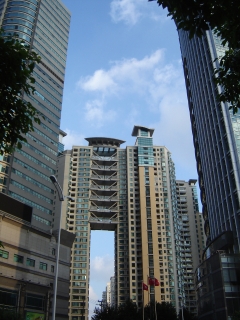
Apartment complex east of Zhongshan Park

and the alleys of the old city:
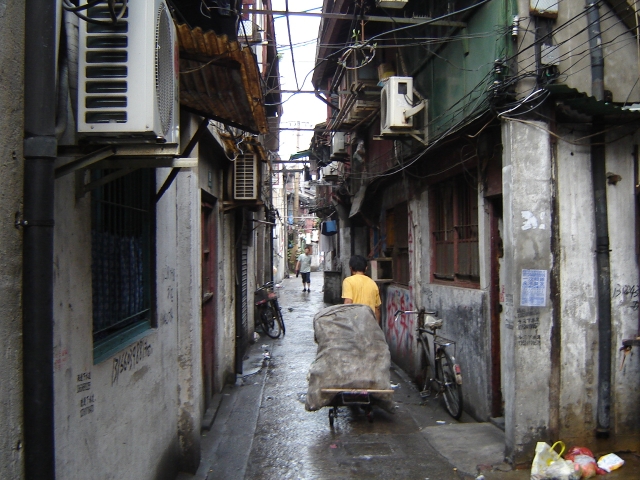
I'll miss the way people do everything right out in public:
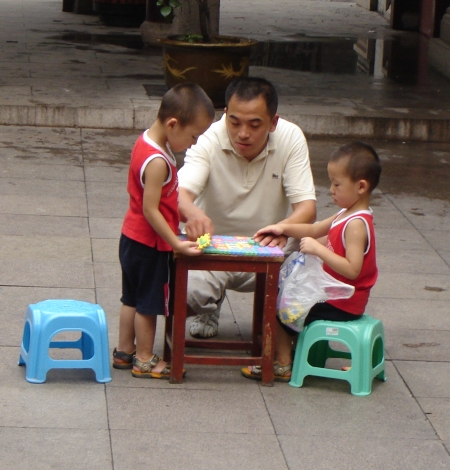
And, I'll miss the rambutans and mangosteens!
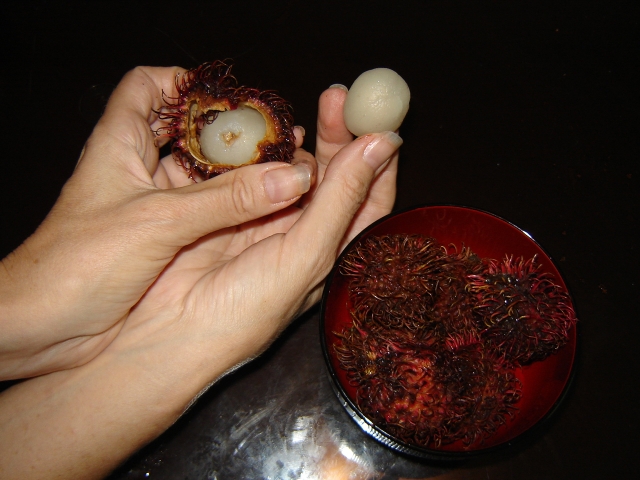
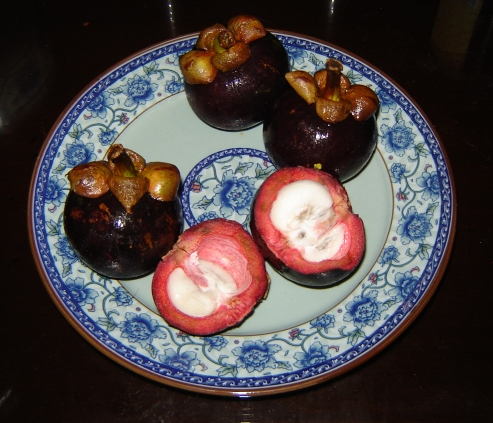
Bristling with red fleshy hairs on the outside, rambutans have have a soft, sweet, slightly tart fruit inside, with a seed in it. They taste a bit like a lychee. They grow in Thailand. Yum!
But mangosteens are even better! These have a thick brittle dark-red rind and a segmented soft white fruit inside. When ripe, they are incomparably tart and zesty. Their charm is enhanced by the fact that it's illegal to import them from southeast Asia or Hawaii to the continental US - the rinds supposedly harbor pests that threaten American crops. It's legal to import them from other places, but so far, it's been impossible to grown them elsewhere. Occaisionally mangosteens smuggled in from Canada make it into New York's Chinatown, but I've never seen one in the US.
This may eventually change - a fellow named Mr. Crown has started growing them in Puerto Rico, after many travails. This year he's managed to harvest 200 pounds, and next year he hopes to harvest enough to be worth selling. He'll FedEx the fruit to two specialty produce distributors, Baldor in New York and Melissa's in Los Angeles. It'll be a while for the price to drop enough to make them worth buying....
In 1902, Rudyard Kipling wrote:
I'll be glad for at least one thing, though, coming back home - the governor of California, Arnold Schwarzenegger, plans to sign a bill limiting greenhouse gas emissions in our state! The California Global Warming Solutions Act of 2006 hasn't been voted on yet, but it's likely to pass this Thursday. Some features include:
The bad news is that President Bush seems to have decided to close the regional libraries of the Environmental Protection Agency:
What has been termed "positively Orwellian" by PEER Executive Director Jeff Ruch, is indeed frightening. It seems that the self-appointed "Decider", George W. Bush, has decided to "end public access to research materials" at EPA Regional libraries without Congressional consent. In an all-out effort to impede research and public access, Bush has implemented a loosely covert operation to close down 26 technical libraries under the guise of a budgetary constraint move. Scientists are protesting, but at least 15 of the libraries will be closed by Sept. 30, 2006.If the EPA were moving to put its material online instead of housing it redundantly in local libraries, that might not be so bad. That's the picture this plan paints: However, this radio show tells a different story:"Public access to EPA libraries and collections will end as soon as possible", according to a report found online at PEER, an acronym for Public Employees for Environmental Responsibility. All total, nearly 80,000 documents, not in digital format, are being boxed up and placed in infinite limbo status by the Bush Administration. The scene from the Raiders of the Lost Ark, where the Ark of the Covenant was wheeled into a massive sea of identical box crates, inside an enormous warehouse, comes vividly to mind.
I've gotten quite absorbed in blogging with my friends on the n-Category Café. I've been posting a lot about logic: first: cartesian closed categories and the λ-calculus, seeing computation as a process, and symmetric monoidal categories in quantum computation, and now also Lawvere's theory of doctrines.
I was very interested in mathematical logic in high school and college, but I ran out of cool stuff to learn (so it seemed) until James Dolan taught me a bit about how category theorists do logic. Since then I've been learning more and more, especially when I go to conferences on category theory and computer science. A lot of theoretical computer science is category theory and logic trying to act practical. Maybe it is practical - I can never tell exactly how practical it is, but it's cool, and that's what I mainly care about.
While learning the λ-calculus and also some bits of Chinese, I've been pondering the logos, the whole idea of words, language, logic. I've been contemplating the "world-making" power of the word. There's a strange way a symbol system brings a world into being. In the λ-calculus, a few basic rules mysteriously generate Boolean logic, the natural numbers, and a universal programming system... it's downright spooky! Chinese is mysterious in a different way: since I don't understand the characters, they evoke the numinous power of writing - magic symbols. There seems to be some sense of this in China, too: calligraphy was traditionally a big deal. A single character, drawn well, can be a work of art. Calligraphy was also one of the accomplishments expected of a cultured person:
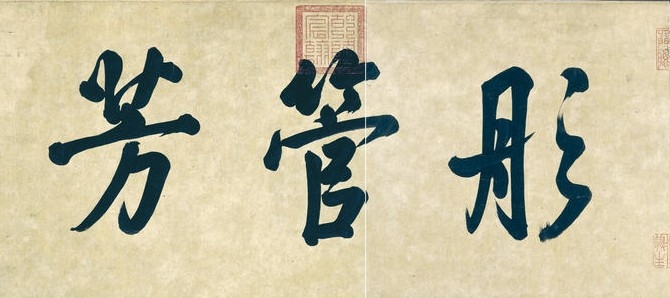
Siu-Leung Lee writes:
Regarded as the most abstract and sublime form of art in Chinese culture, "Shu Fa" (calligraphy) is often thought to be most revealing of one's personality. During the imperial era, calligraphy was used as an important criterion for selection of executives to the Imperial court. Unlike other visual art techniques, all calligraphy strokes are permanent and incorrigible, demanding careful planning and confident execution. Such are the skills required for an administrator / executive. While one has to conform to the defined structure of words, the expression can be extremely creative. To exercise humanistic imagination and touch under the faceless laws and regulations is also a virtue well appreciated.
On a related note, I just saw a webpage on the origin of Babylonian writing on clay tablets:
Before people in the Near East wrote on clay tablets, there were "tokens":
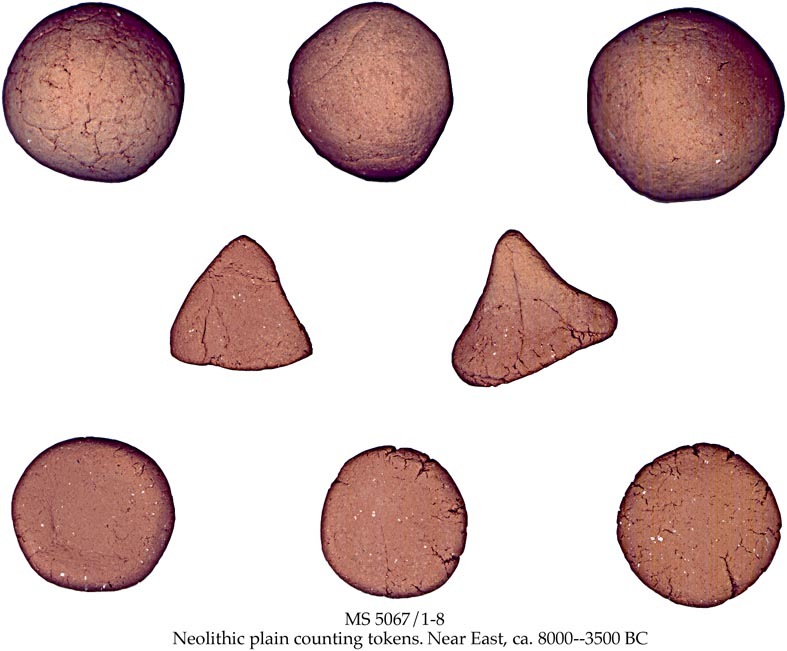
These are little geometric clay figures that represented things like sheep, jars of oil, and various amounts of grain. They are found throughout the Near East starting with the agricultural revolution in about 8000 BC. Apparently they were used for contracts!
Eventually groups of tokens were sealed in clay envelopes, so any attempt to tamper with them would be visible.
But, it's annoying to have to break a clay envelope just to see what's in it. So, after a while, they started marking the envelopes to say what was inside. At first, they did this simply by pressing the tokens into the soft clay of the envelopes.
Later, these marks were simply drawn on tablets. Eventually they gave up on the tokens - a triumph of convenience over security. The marks on tablets then developed into the Babylonian number system! The transformation was complete by 3000 BC.
So, five millennia of gradual abstraction led to the writing of numbers! From three tokens representing jars of oil, we eventually reach the abstract number "3" applicable to anything. (But tokens are already abstract - I wonder how they were developed.)
Of course, all history is detective work. The story I just told is an interpretation of archaeological evidence. It could be wrong. This particular interpretation is due to Denise Schmandt-Besserat. It seems to be fairly well accepted in broad outline, but scholars are still arguing about it.
For more on her ideas, try this:
For a bibliography of her many papers, try:
For more work on this subject - I want to read more! - try:
And for a fun intro to writing on clay tablets, try this:
I have a colleague at UCR named Chessie Rochberg who works
on Akkadian astronomy and mathematics. It would be fun to talk to
her about this stuff. Unfortunately she'll be at the Institute
for Advanced Studies this year.
September 9, 2006
Today we took the subway to Pudong, the new part of town. They're
building new skyscrapers there. We went to a huge shopping
mall called Super Brand Mall, bought some coffee beans,
and had some wine in a little cafe.
At some point while wandering the mall my bowels started doing painful and unpleasant things - not usual here - and I had to quickly find a toilet. Alas, it was a squat toilet, meaning a kind of porcelain-lined hole in the floor of the toilet booth which you somehow squat over as you shit. Fancy places often have Western-style toilets - so I sort of expected one here in this fancy new mall - but most places don't.
Since nobody ever taught me the correct way to use a squat toilet, all ways seem equally uncomfortable, especially since the floor is often wet and slippery. Furthermore, you're expected to bring your own toilet paper, just you often need to bring your own napkin to the less fancy Chinese restaurants. You buy little packs of kleenex which serve for both these purposes. I always keep one in my pocket. That's fine. But, when you're done wiping yourself you're supposed to throw the paper in a little wastebasket, not the toilet itself - on the theory that toilet paper clogs pipes more than crap does. This seems a bit dubious to me, but who am I to say? I haven't done systematic experiments. Having a basket of used toilet paper nearby as I squat does, however, make the whole experience a bit less pleasant.
But the worst part of this whole business is that I usually forget to remove the pack of kleenex from my pocket until I'm crouched over the squat toilet on the slick floor with my pants half down. This makes it hard to get at the kleenex. At this point I have to do some complicated maneuvers. I'm always afraid I'm going to slip and land in the toilet. So far I never have.
As I squatted there, suffering from lengthy gastro-intestinal woes, I started fantasizing about how wonderful a Western-style toilet with a nice seat would be just now. A toilet like that is practically a throne! You can sit there comfortably, and the top half of you can ponder life philosophically, very much like Rodin's The Thinker in fact, while the bottom half of you does its business. You can even read a book! There's no way I could dream of reading a book on a squat toilet.
But just then, irony of ironies, I looked up and saw this sign in front of me:
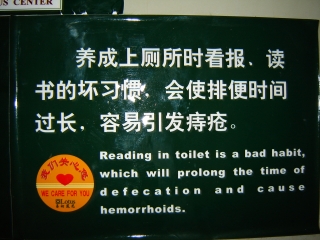
I mention all this just in case my diary is giving you too romanticized an impresson of life in China.
Later that evening we went to the Peace Hotel on the Bund and had
a drink on the roof, looking over the river. We bought a
scroll from a store near the hotel, because it has nice calligraphy
and consists of a little excerpt from Romance of the Three
Kingdoms, which Lisa studied in her dissertation.
September 10, 2006
Today is Teacher's Day, that day when we all honor our teachers...
here in China, anyway. One of Lisa's Chinese students called her from the
States! Apparently some restaurants even give teachers a discount today,
but we didn't try it when we ate at our favorite Hunan restaurant on Zhengmin
Road - restaurants are so cheap here anyway.
This dinner came after a little adventure. North of Fudan University is a small triangular patch of ramshackle houses called Ye Shi Lu, or "Ye's Road". We read about it in this article, and it sounded so depressing we decided to take a walk and find it:
Ye Shi Lu (Ye's Road) is now almost a slum and serves largely as a place of residence for immigrant labor from the other provinces. Located in the northeastern Yangpu district of Shanghai city, Ye's Road is a short narrow cement pathway stretching from northeast to southwest, about 190 m in length. In recent years, dwellers in teh precinct have taken to using the name of this so-called "road" to refer to the almost triangular block to the south of it. There are more than 100 houses that are single or double-storied, and illegal hovels have been built to be rented out to immigrants. Within the 0.5 hectares of this area dwells a population size of no less than 1,200.He adds that "Illegal babies are also rather rife inside the Ye's Road block" - a reference to the one-child policy.Ye's Road block is encircled with a hospital, colleges and newly-built residential buildings. They are Shanghai Lunger Hospital, Huiwen Yuan (Gentle's Garden), Ji-Guang College, and Fudan University. Compared with these surrounding units, Ye's Road is dirty, disorderly, and severely lacking in fundamental urban facilities. Largely incongruent to the surrounding area, it has become a concourse of social problems to the local government.
A 2004 government report quoted in this paper makes the area seem even more ominous:
One who came to Ye's Road for the first time must be confused. Small houses are located closely by each other without order, illegal buildings and dangerous hovers can be found everywhere, and bundles of rubbish or pushcarts lay strewn along the zigzag pathway. No cloacae, no septic tank, and not even basic sanitation such as toilets or dustbins. Garbage and filth is everywhere along the alley, and the former railway beside Ye's Road is a "natural" septic tank and refuse dump, where rubbish accumulates to piles, and the smell of rot, ferment and urine stink is simply unbearable. Almost every family cooks in the same room the members are living in, and the stove is close to combustible things. Electrical appliances and wires are in a mess, and some inhabitants even steal electricity from electrical poles. Houses built in Ye's Road block are all of brick-wood structure, small and dense, thus the danger of fire breaking out is unusually high. in case of a fire emergency, fire engines can't get close, leaving the lives and properties of the inhabitants at stake. The dirty, disorderly, and unsafe situation of Ye's Road is a stark contrast to the surroundings.The reason for this situation is that poor immigrants come in from the countryside to make money. Ding Yan-nan and Zhou Hong-yan, a senior in the Sociology Department at Fudan University, took a survey last summer and found 1300 people living in Ye's Road, of whom only 200 are native to Shanghai. Most of them had never attended high school, and about half work as food peddlers, cooks or waitresses. The average income per family is Y1100 yuan per month (roughly $140). These families typically live in a single room about 12 square meters in size; such a room rents for Y300 per month. Housing prices are going up fast: a year before such a room cost about Y200. When anyone living here saves up enough money to take out a mortgage on an apartment, they leave and rent out their room to new immigrants.
Ding Yan-nan explains why this situation perpetuates itself. The immigrants won't invest to improve this area, because they are poor and leave as soon as they can. The people who own the houses won't, because they could only pay for this by increasing rental prices, which their tenants can't afford. Local businesses don't chip it, because it's unprofitable, at least in the short term. And, the local government is too preoccupied with other projects - such as much more profitable real estate development schemes.
Anyway, I won't give you the detailed tale of our search for this slum. First we came across the train track, but didn't feel like walking down it. Then we continued to walk until we'd almost given up, when we saw an entrance-way to a little alley off a main street. By the way, the phone numbers you see on the left of the wall here are for people who sell illegal documents - you find these everywhere in Shanghai, just like you find graffiti in the US:
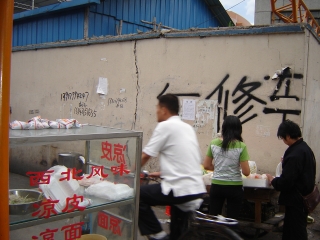
We went in and sure enough, it was Ye's Road! There were a bunch of food peddlers with booths near the entrance, and further in small houses - and, oddly, 3 pool tables in the open air, each surrounded by men playing pool on a Sunday afternoon. The usual table of guys playing card with a big audience surrounding them. Lots of dogs and puppies, children playing, and so on. The road ended in a garden. It was not as depressing as the government report made it sound - actually a lot like the Old City, but less dense and with smaller houses.
I didn't take any pictures because it would be a bit like taking a photo in someone's house, and we felt fairly out of place even without acting like tourists. It's unfortunate, though, because it was an interesting place.
We walked out and continued walking down the road, which swerved left and became Zhengmin Road. Right at the bend I noticed a little alley which also seemed to lead into the Ye's Road area. Maybe this was Ye's Road. We walked down it a bit until we came to some houses of a much more primitive sort than we'd seen at the other end:
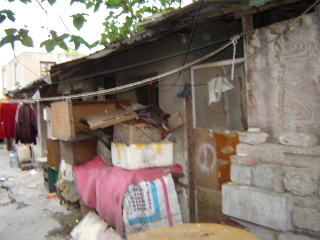
Since there were some people standing in the alley further down watching us, and it was quite narrow, we turned around and left. We didn't feel unsafe - Shanghai is incredibly safe compared to big American cities, and I've never met any "tough guys" of the sort you see in bad neighborhoods in the US: guys who seem to be looking for a fight. We didn't see any guys like that here either: just people trying to survive and maybe have a little fun! But, it didn't feel good to have people watching me take photos. They might think I was going to get them in trouble somehow.
By the way, in case Frank
Chiu is reading this:
we finally tried some salt water and green bean ice sticks -
they're great! The picture of green beans on the wrapper
looks a bit scary, like a pile of peas, not what I normally
fancy in a popsicle. But, they're actually mung beans, and they
taste sort of like chocolate! We get them whenever we can now.
We even had one while looking for Ye's Road.
September 12, 2006
It's sort of horrifying that I'm going to leave Shanghai and Lisa
and return home next Wednesday. As Bob Dylan sings,
We're going to visit Hangzhou on Thursday, staying for three nights. We'd been meaning to stay for two nights and then take an overnight boat to Suzhou, spending a day there and a night at the romantic Pingjiang Lodge. But the boat trip takes 14 hours, and I don't really feel a desperate urge to see more of Suzhou, except for that hotel, so I regretfully decided that this time would be better spent exploring Hangzhou. People say it's great!
It's been raining, raining, raining and chilly the last two days.
I've been listening to lots
of Dylan lately, from Blood on the Tracks and Desire.
As I get older I like his soul more, and discover that his strange rough
voice is, in its own way, perfect.
September 14, 2006
We took a train to Hangzhou at noon, arriving there at 2:30 and
taking a cab to the Xinqiao Hotel on Jiefang Road.
It was cool, misty, and raining slightly, but I was eager to
see the famous West Lake, spanned by the Bai and Su
causeways and dotted with features with romantic names like
Three Pools Mirroring the Moon, the Solitary Island, Broken
Bridge and the Mid-Lake Pavilion. So, we took a walk up
from Jiefang Lu along the lakeside park to the Baidi, or
"Bai Causeway", a beautiful thin finger of land
leading to the Solitary Island.
I can't find any decent online maps of Hangzhou in English, so you'll have to look at this photo to get a sense of its magical geography. See the orange east-west road on the right? That's Jiefang. See the little strip of land on the northwest of the lake? That's the Bai Causeway, leading to the Solitary Island.
As we walked with open umbrellas through intermittent showers, we saw some boatmen plying the misty waters:

and others lined up waiting to ferry tourists from isle to isle:

Not many customers this evening! One urged us to take a boat ride tonight and do our walking tomorrow when it would be sunny. His fellow boatmen laughed out loud at this.
We had dinner at Louwailou, a famous restaurant on the Solitary Island which dates back to around 1848 or so. Zhou Enlai used to eat there, and it commands high prices, but I'd say it's overrated, resting on its laurels by now. We had various dishes including beggar's chicken and a bit of Dongpo pork, which are specialties of Hangzhou and especially this restaurant.
Beggar's chicken is made by stuffing a chicken with lily pods, mushrooms, beef and other seasonings, wrapping it in leaves from the lotus plants that grow on the shores of the West Lake, then wrapping all that in mud (or these days, saran wrap and then newspaper) and baking it in an oven for three hours. The name has an interesting story behind it. Here's one version, slightly polished up from Louwailou's website:
It happened long long ago. The federal government imposed a heavy tax on civilians, and people were deprived of everything. Families broken up, they strayed everywhere as beggars. One day, a beggar was wandering in Changsu of Jiangsu Province, cold and hungry. Eventually he couldn't stand up anymore, and he fainted. His fellow sufferers tried to save him. They collected wood and burned it to warm him up. One fellow sufferer took out their only remaining chicken and prepared to cook for him. But without any implements for cooking, they were very worried. Suddenly, one of them got an idea. He suggested wrapping up the chicken with mud and putting the mud pie into fire to bake. So, they collected wood and baked a mud pie. Finally, when the chicken was fully cooked, they knocked it open. To everyone's surprise, the feathers also fell off with mud, and the chicken smelled very nice. The aroma attracted all neighbors around. They came and couldn't stop praising the unique cooking style and the unique taste.Later, Louwailou absorbed this cooking experience and made some improvements. They take "Yue Chicken", Shaoxing wine and lotus leaves from the West Lake as their ingredients. First, they kill a fresh Yue chicken and clean it, add all kinds of spices, and stuff condiments into the chicken's stomach. Then they bind it with West Lake lotus leaf, wrap it with a kind of mixture of Shaoxing wine, salt water and mud from a wine jar. Finally, they bake it in steady fire for three to four hours. The mud pile is opened in front of the guests. Because the chicken is cooked in a sealed envelope, the original taste is perfectly kept, and with the flavor of wine penetrating into chicken, you will smell a fragrance when opening the mud. This dish is full of not only nutrition but also sentiment. That's why when tourists come to Hangzhou, they all want to taste this traditional and famous dish.
Ironically, beggar's chicken costs quite a lot at Louwailou, at
least by Chinese standards - Y120. But, it was worthwhile,
just for the experience.
September 15, 2006
It was still misty,
but we took a boat ride first to the Mid-Lake Pavilion and then to
Xiaoyingzhou Isle, stopping to wander around on both. As you
can see on this map,
Xiaoyingzhou is a wonderful manmade isle shaped like a circle
surrounding a cross, leaving four quadrants of lake inside.
As the Chinese saying goes,
Clearly they enjoy these topological complexities just as much as I do!
To the south of Xiaoyingzhou are three small floating pagodas:

On certain holidays people light candles on these, and watch their light reflected in the enclosed pools of water surrounding them. So, they're called Three Pools Mirroring the Moon.
We then caught a boat to the Solitary Isle and ate a great dinner of pumpkin congee, dandan noodles and beggar's chicken from a booth near a teahouse east of Louwailou. The beggar's chicken cost Y32 - cheap compared to the Y120 we spent at Louwailo, and they reheated it in a microwave, but I swear it tasted better! We fed the feet to a cat that was meowing piteously in the shrubs below the pavilion. It definitely had its act down pat.
There are lots of cats in the apartment complexes of China; I can never tell if someone owns them or if they're just living off handouts and garbage. In our complex, the usual way to deal with garbage is to put it in small plastic bags outside the front door of the building. Then later someone comes and picks it up and puts it in an outbuilding where people carefully open it up and remove anything recyclable or otherwise usable - part of an elaborate system which I don't fully understand. But at night, cats will often get into these bags and scavenge. They run away when I walk by.
September 16, 2006
Today we climbed through forests in the Geling Hills
northwest of the lake,
first to a nice teahouse amid the trees where we had dumplings in excellent
fish broth, and then to Baochu Pagoda. One can see this slender spire
from anywhere on the lake, towering off in the distance:
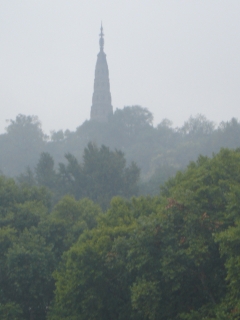
Then we headed west, climbing up a stairway between large rocks, then down a trail which led to a Taoist monastery called the Baopu Daoyan:
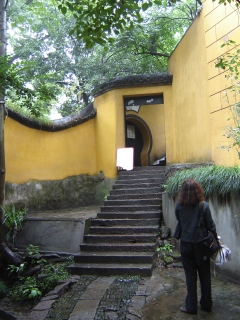
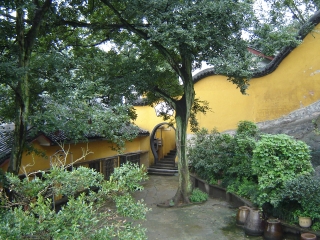
This was the real goal of our expedition. Lisa had visited once before, but it doesn't show up on any maps or tour guides, so it's peaceful and a bit mysterious. First we looked at the temple:
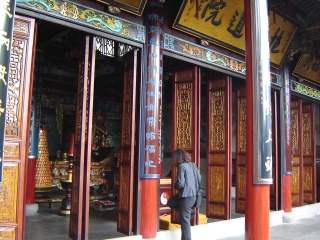
Lisa wanted her fortune told if possible, since she's writing a book comparing classical Greek and Chinese divination techniques. Traditionally, fortune tellers hang out in or near Taoist temples. So, she asked a fellow sitting at a desk in the temple if they did fortune telling there. He laughed and said no. But later, we found our way to another little temple upstairs, with figures of 60 gods - one for each year in the 60-year cycle of Ten Heavenly Stems and Twelve Earthly Branches, on which the old Chinese calendar is based. And Lisa noticed a fortune-teller at work up there! So, she got her fortune told, based on astrology.
It took quite a while, so I sat around doing a little math and enjoying the scenery. I noticed some pictures of bats on a little outbuilding:
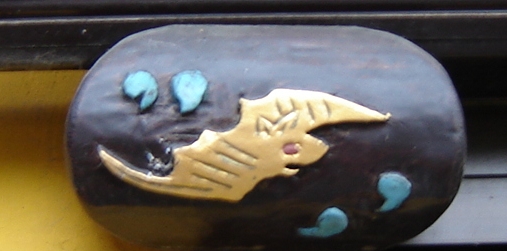
In China bats are symbols of good luck! I saw lots of bats winging around Shanghai, Suzhou and Hangzhou at dusk, swooping artfully to catch insects.
When Lisa's fortune-telling session was done, we left through the front door - on the south, following good feng shui principles. To the right of this door, tucked amid the ornamental rocks, we found something Lisa had been looking for! It was a little well, whose waters were used by Ge Hong for preparing elixirs. Ge Hong was a famous Taoist master, physician, pharmacist and alchemist who lived from about 284 to 343 AD. He wrote an influential book called the Baopu-zi wai pian, about "internal alchemy". And, apparently this is where he lived!
After looking around a bit, we bid the place a fond adieu:
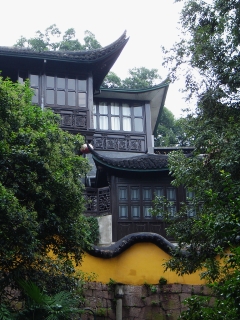
and walked back down the hill to the lake.
Then we hired a boatman for Y120 (about $15) to take us around for an hour. We wanted him to take us home, but that was against the rules, supposedly. So, he took us under the Bai Causeway:

under the Su Causeway, and west into a series of small lakes. It was beautiful.
After returning, we walked back along the Bai Causeway, watching more boats in the dim evening light:
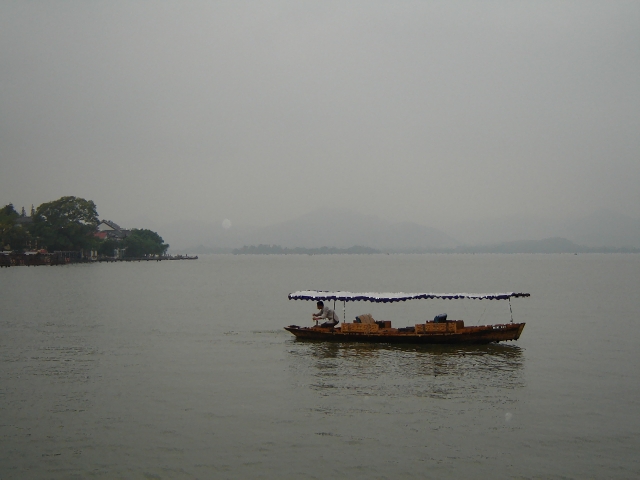
September 21, 2006
Back in Riverside California, jetlagged and groggy.
I got an email from Warren D. Smith, a mathematician who advocates a voting system called range voting. I've never gotten deeply into the whole issue of optimal voting systems. One guy in the math department liked "preference voting" for department elections, but the main effect was to spur endless arguments at department meetings about how to vote on an optimal voting system. This is an opportunity for some serious self-referential mayhem when you've got a bunch of mathematicians involved, so I got pretty sick of discussing meta-meta-meta-issues instead of actual issues. But, I'm glad someone is thinking about optimal voting systems... though I doubt they'll ever get adopted except in small new organizations, since a main form of entrenched political power is precisely control over procedures like voting.
Anyway, I enjoyed Smith's comments on how honeybees and ants have more rational voting procedures than humans.
September 22, 2006
Ever wonder why nobody has caught Osama bin Laden, who some
believe is hiding in Pakistan near its border with Afghanistan?
Ever wonder if maybe Pakistan is a somewhat reluctant ally of
the US? People say its dictator, Pervez Musharraf,
is walking a fine
line trying to deal with the powerful militant Islamic groups in his
country. That's probably true - but what kind of US ally would
let their leading nuclear scientist help North Korea, Iran
and Pakistan with their nuclear weapons programs?
Well, this news sheds some interesting light on it all! Shortly after September 11, 2002, the US deputy secretary of state Richard Armitage threatened Musharraf that the US would bomb Pakistan back to the Stone Age if they refused to help with the war on terrorism.
Now that's what I call subtle diplomacy! Leaning hard on Pakistan seems quite justified, but isn't it counterproductive to show the iron fist inside the velvet glove in such a crude manner? Armitage is the same clever fellow who blew the cover of CIA agent Valerie Plame after her husband refused to buy the story that Saddam Hussein was trying to get uranium ore from Nigeria.
Amazingly, this news comes from an interview with Musharraf himself:
Armitage denies it all.US Threatened to Bomb Pakistan, says Musharraf
The Telegraph
September 22, 2006
President Pervez Musharraf of Pakistan said that after the September 11 attacks the US threatened to bomb his country if it did not co-operate with America's war against the Taliban in Afghanistan.
Gen. Musharraf, in an interview with the CBS news magazine show 60 Minutes, that will be broadcast at the weekend, said the threat came from the deputy secretary of state, Richard Armitage, and was given to Gen. Musharraf's intelligence director.
"The intelligence director told me that (Armitage) said, 'Be prepared to be bombed. Be prepared to go back to the Stone Age,'" Gen Musharraf said. "I think it was a very rude remark."
Not long afterwards Pakistan announced it was standing with America and its allies in fighting terror. It granted permission for US fighter jets to use Pakistani airspace as the attack began on the Taliban and al-Qa'eda, which were protected by the Afghan militia.
Isn't politics a can of worms? Sometimes it gets so disgusting it's almost funny. Like this news story a while back:
Opposition parties and pro-democracy activists had asked the Supreme Court to declare Musharraf's referendum unconstitutional, but the justices ruled Saturday that the vote could go ahead.Oh, then it's okay.The court ruled that Musharraf was not violating the constitution because he had suspended it two days after the coup.
LA Times, p. A12, May 2, 2002.
Meanwhile, the mystics beckon:
Out beyond ideas of wrongdoing and rightdoing, there is a field. I'll meet you there. - Rumi
I'll be back on
Wednesday the 27th, just in time to start teaching the next day.
September 28, 2006
After a relaxing visit with Bruce and family, I zipped back
home. I'm still jet-lagged, so I woke up too early. Some folks
in the math and computer science departments are having a seminar
on Categories and Computation, so I went to that from 9:40 to
11:00 am before teaching my own seminar
from 11:10 to 12:30. This
will cover two topics this fall: Classical versus
Quantum Computation on Thursdays. No other teaching this fall, just
meeting with lots of grad students, so I can be ambitious.
I want to make notes for my seminar show up on my
blog, so people
around the world can follow along and comment. A fun experiment.
September 30, 2006
At 5:30 pm I went to the Starbucks at the University Village near UCR and
talked to James Dolan. This has long been one of our favorite hangouts:
powered by frappucinos, we sit around and do math for hours. He's been working
with Todd Trimble on categorifying everything associated to simple
Lie groups and quantum groups, and they've come up with some cool stuff.
I was pretty heavily involved before I went to Shanghai, but now I need
to catch up. I don't have anywhere near enough time to talk with Jim
about this stuff, much less write it up for the world to see. But,
I want to try! The material is getting really fascinating at this
point, after several years of work. Enormously deep patterns. It's
like peering down into the foundations of the universe and seeing
the mysterious machinery that makes it tick.
While we were talking, some religious propagandist handed us a fake million-dollar bill with a picture of some fat president on it - Garfield? I forget. This got us talking how the bigger the bill is, the more obscure the president that adorns it. As usual, Jim's vast knowledge of trivia was highly entertaining. I had never heard of the $10,000 bill with Salmon P. Chase on it - not even a president!
I'd never heard of him - he was treasurer under Lincoln. Nor had I seen the episode of The Simpsons where Homer had to track down a trillion-dollar bill for the FBI.
But, as usual with Jim's knowledge of trivia, it got a bit fuzzy at the edges, so I had to hit the Wikipedia afterwards and read about large-denomination bills and fake bills. Quite entertaining! The biggest bill ever printed by the US was the $100,000 Woodrow Wilson bill:
It was bright orange on the back! Alas, the highest denomination printed has been a measly $100 ever since 1945, and in 1969 Nixon signed a law officially eliminating all the bigger ones, to fight organized crime. There are only about two hundred $5,000 and three hundred $10,000 bills known, all owned by collectors I guess.
Afterwards I had fun polishing this puzzle: What happened when Fidel Castro's brother took a ride in this flying car?
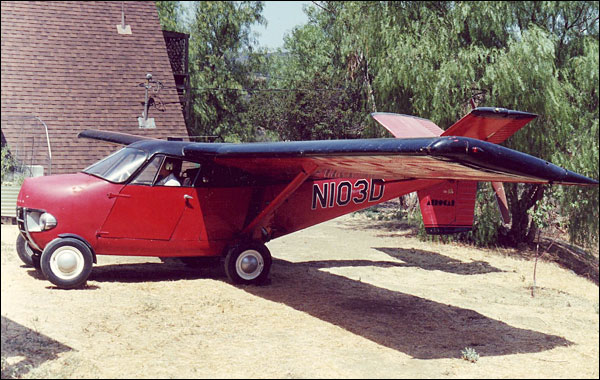
I love implausible-sounding questions like this - especially when the answers are even more implausible (but true). If you get stuck, see puzzle 30 on my puzzle page.
© 2006 John Baez
baez@math.removethis.ucr.andthis.edu